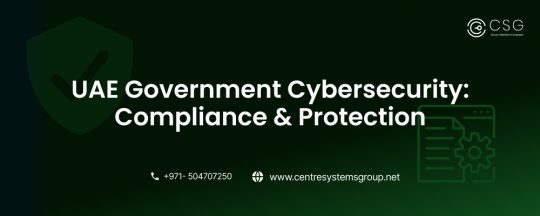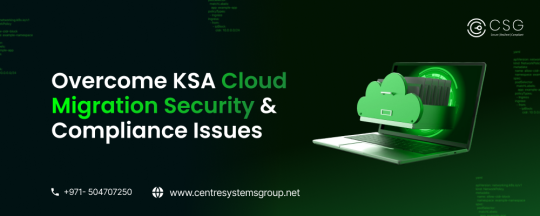Centre Systems Group (CSG) is a global technology consulting powerhouse specializing in cybersecurity.
Don't wanna be here? Send us removal request.
Text
UAE Government Cybersecurity: Compliance & Protection

The United Arab Emirates is one of the fastest-growing digital economies in the world. From smart cities to paperless governance and AI integration — the UAE is betting big on technology. But with innovation comes cyber risk. In response, the UAE government launched its National Cybersecurity Strategy (NCS) to secure the digital transformation.
In this blog, we decode the UAE Cybersecurity Strategy for 2024–2025, explore what it means for businesses, and outline how you can align your organization with national goals.
2. What Is the UAE Cybersecurity Strategy?
The National Cybersecurity Strategy is a government-wide framework designed to:
Build a secure and resilient cyber environment
Protect critical digital infrastructure
Enhance national and economic security
Promote trust in digital services
It is overseen by the UAE Cybersecurity Council, which was established in 2020 and reports directly to federal authorities.
3. Key Objectives of the 2024–2025 Strategy
The updated strategy, launched in late 2023, outlines five strategic pillars:
1. Cybersecurity Governance & Policy
Introduce a unified cybersecurity legal framework
Ensure coordination between federal and emirate-level agencies
Standardize cybersecurity compliance across sectors
2. National Cyber Resilience
Protect Critical Information Infrastructure (CII)
Improve response to large-scale cyber attacks
Establish Sectoral CSIRTs (Cybersecurity Incident Response Teams)
3. Cybersecurity Innovation & Research
Support local development of cybersecurity tools and platforms
Establish national bug bounty programs
Fund academic research in AI-powered security
4. Cybersecurity Workforce Development
Train 50,000 cybersecurity professionals by 2026
Create certification programs and skill standards
Encourage women and youth participation in cybersecurity
5. International Collaboration
Build partnerships with global cybersecurity agencies
Harmonize cross-border data protection and cyber laws
Participate in global incident response exercises
4. How This Strategy Impacts UAE Businesses
Whether you’re a fintech startup, logistics company, or a real estate giant — the strategy directly affects your digital operations.
Here’s how:
✅ Mandatory Compliance RequirementsSectors like finance, healthcare, telecom, and government contractors will need to meet updated regulations related to data protection and incident reporting.
✅ Vendor Risk Oversight You will be required to vet third-party vendors for cybersecurity compliance — especially cloud providers and payment platforms.
✅ Employee Training ExpectationsInternal awareness and cybersecurity training will be expected — not just optional.
✅ Incident Response ReportingOrganizations must report certain cyber incidents within defined timeframes, similar to the Personal Data Protection Law (PDPL).
5. Real-Life Application: The Dubai Smart City Push
As Dubai rolls out 5G-powered smart infrastructure, the Cybersecurity Strategy mandates that all government and semi-government entities integrate security-by-design models in their digital transformation.
This means any business working on IoT devices, AI applications, or smart services must meet minimum cybersecurity benchmarks to qualify for contracts.
6. How to Align Your Business with the Strategy
Here’s a roadmap for proactive alignment:
✅ Step 1: Understand Your Risk Profile
Identify your digital assets, data categories, and critical business processes.
✅ Step 2: Conduct a Cybersecurity Gap Assessment
Compare your existing cybersecurity practices with expected controls outlined by the UAE Cybersecurity Council.
✅ Step 3: Build a Governance Framework
Appoint cybersecurity leads, develop internal policies, and prepare a documented incident response plan.
✅ Step 4: Invest in Security Technology
Adopt solutions for:
Email security
Network segmentation
Endpoint protection
Cloud security posture management
✅ Step 5: Educate and Train Your Teams
Train all employees on phishing, password hygiene, and incident reporting. Run mock drills.
✅ Step 6: Partner with a Cybersecurity Advisor
Consult with firms like Centre Systems Group to stay updated, implement controls, and conduct penetration testing.
7. How Centre Systems Group Can Help
At Centre Systems Group, we provide end-to-end support to align your operations with the UAE’s 2025 Cybersecurity Strategy.
Our services include:
✅ Security policy development ✅ Cyber risk audits and ISO 27001 alignment ✅ Employee awareness training programs ✅ Cloud security consulting ✅ Managed detection and response (MDR) ✅ PDPL and NESA compliance implementation
We combine local market understanding with global best practices to help you meet every regulatory and security requirement confidently.
Cybersecurity in the UAE is no longer just about protecting data — it’s about enabling a secure digital future. The UAE’s Cybersecurity Strategy 2024–2025 reflects the country’s ambition to lead in digital innovation without compromising national security.
For businesses, this is both a challenge and an opportunity. Those who act early can gain compliance, client trust, and a competitive edge.
📩 Partner with Centre Systems Group to future-proof your business against emerging cyber risks — and stay aligned with the UAE’s strategic vision. Source Url: https://centresystemsgroup.net/blog/understanding-the-uae-cybersecurity-strategy-2024-2025/
0 notes
Text
Overcome KSA Cloud Migration Security & Compliance Issues

The Kingdom of Saudi Arabia (KSA) is undergoing a significant digital transformation fueled by initiatives like Vision 2030. As businesses in the region embrace innovation, cloud migration has emerged as a key driver for scalability, cost-efficiency, and enhanced service delivery. However, transitioning to the cloud is not without challenges. Organizations in KSA must navigate complex security, compliance, and operational hurdles to achieve a seamless migration process.
This article explores the major challenges associated with cloud migration in KSA and provides actionable strategies to overcome them, ensuring security and compliance.
1. Cloud Adoption Trends in KSA
Cloud adoption in KSA is accelerating across various industries, including finance, healthcare, and government. This growth is driven by the need to modernize infrastructure, optimize costs, and meet the demands of a rapidly evolving digital landscape.
Key Drivers of Cloud Adoption in KSA:
Vision 2030: The Saudi government’s Vision 2030 initiative emphasizes technology-driven economic diversification, encouraging organizations to adopt advanced technologies like cloud computing.
Increased Investments: Global cloud providers, such as AWS, Microsoft Azure, and Google Cloud, are establishing data centers in KSA to cater to local demands.
Remote Work and Digital Services: The COVID-19 pandemic accelerated the adoption of cloud solutions to support remote work and digital transformation.
Market Growth Statistics:
The cloud computing market in KSA is projected to grow at a compound annual growth rate (CAGR) of 25% between 2021 and 2026.
Sectors like banking, healthcare, and education are leading in cloud adoption due to their reliance on secure and scalable IT solutions.
2. Major Challenges in Cloud Migration
While the benefits of cloud migration are undeniable, organizations in KSA face several challenges that must be addressed for a successful transition.
a. Security Concerns
Security remains one of the top challenges during cloud migration. Organizations are vulnerable to threats such as:
Data Breaches: Sensitive data can be exposed during the migration process due to improper handling or insufficient encryption.
Misconfigurations: Errors in cloud configurations can create entry points for cyberattacks.
Insider Threats: Unauthorized access by employees or third-party vendors can compromise data integrity.
b. Compliance with Regulatory Requirements
KSA has a stringent regulatory environment to protect data privacy and national security.
SAMA Cyber Security Framework: Financial institutions must comply with the Saudi Arabian Monetary Authority’s (SAMA) guidelines to ensure secure operations.
Data Sovereignty: Organizations must store and process sensitive data within the country’s borders, adhering to local laws.
Cross-Border Data Transfer Restrictions: Global companies operating in KSA face challenges in transferring data across borders while complying with local and international regulations like GDPR.
c. Lack of Skilled Workforce
A shortage of skilled cloud professionals is a significant barrier to seamless migration. Organizations often struggle to find talent with expertise in:
Cloud security and compliance.
Cloud-native application development.
Advanced tools for monitoring and optimization.
d. Migration Downtime and Business Disruption
Cloud migration can disrupt normal business operations, leading to:
Service interruptions that affect customer experience.
Delayed processes and productivity losses.
Increased pressure on IT teams to resolve technical issues quickly.
e. Cost Management
While cloud adoption is cost-efficient in the long term, migration itself can incur:
High upfront costs for infrastructure upgrades.
Unexpected expenses due to extended timelines or unplanned resources.
Overruns caused by a lack of clear budgeting.
3. Best Practices for Overcoming Cloud Migration Challenges
Organizations in KSA can overcome these challenges by adopting best practices tailored to their unique operational and regulatory needs.
a. Conduct a Comprehensive Assessment
Start with a detailed evaluation of your current IT infrastructure to identify:
Workloads suitable for cloud migration.
Security vulnerabilities and areas requiring improvement.
Estimated costs and timelines for migration.
Tools: Use cloud readiness assessment tools like AWS Migration Evaluator or Microsoft Azure’s Total Cost of Ownership (TCO) calculator.
b. Develop a Clear Migration Strategy
A well-structured migration plan minimizes risks and ensures a smooth transition.
Phased Migration: Migrate workloads in phases to reduce disruption.
Prioritization: Focus on mission-critical applications first, followed by less critical ones.
Backup Plans: Maintain on-premises backups during migration to prevent data loss.
c. Ensure Compliance with KSA Regulations
Work closely with legal and compliance experts to meet regional requirements:
Align with the SAMA Cyber Security Framework for financial institutions.
Use local data centers to address data sovereignty concerns.
Consult with compliance specialists to navigate cross-border data transfer restrictions.
d. Leverage Advanced Security Solutions
Implement robust security measures to protect data during migration:
Encryption: Use end-to-end encryption for data in transit and at rest.
Identity and Access Management (IAM): Restrict access to authorized personnel only.
Zero-Trust Architecture: Adopt a “never trust, always verify” approach to access control.
e. Train and Upskill IT Teams
Invest in training programs to bridge skill gaps:
Encourage certifications in cloud platforms like AWS, Azure, and Google Cloud.
Conduct workshops on compliance and security best practices.
Provide hands-on experience with cloud migration tools.
f. Partner with Trusted Cloud Service Providers
Choose cloud providers with a strong presence in KSA:
Evaluate their compliance readiness and security measures.
Ensure they offer support for local regulations like data sovereignty.
Leverage managed services to reduce the burden on in-house IT teams.
g. Monitor and Optimize Continuously
After migration, focus on optimizing performance and costs:
Use monitoring tools to detect vulnerabilities.
Regularly review cloud usage and adjust resources to avoid overspending.
Perform audits to ensure ongoing compliance.
Conclusion
Cloud migration presents immense opportunities for businesses in KSA, but it also comes with challenges that require careful planning and execution. By addressing security concerns, complying with regulatory frameworks, and leveraging advanced tools and practices, organizations can achieve a smooth and secure transition to the cloud.
At Centre Systems Group, we specialize in providing end-to-end cloud migration services tailored to the unique needs of KSA businesses. Contact us today to ensure a secure and compliant journey to the cloud.
Source Url: https://centresystemsgroup.net/blog/cloud-migration-challenges-in-ksa-overcoming-security-and-compliance-issues/
1 note
·
View note